 Debian Trends
Debian Trends
Introduction
Debian packaging practices evolved over time. This page provides some historical perspective about how those practices evolved. This data was generated with lintian, a rather basic script, data from snapshot.debian.org starting in 2005, and computational power from Grid'5000. This is a static page, last refreshed in December 2025. If it is not fresh enough, nag the author!
All graphs are for Debian testing (main only, not contrib/non-free), because there is a number of unmaintained or abandonned packages in Debian unstable that we do not want to report about. Alternate graphs with Debian unstable are also provided. Each graph provides the number of packages in each case over time. Vertical lines indicate release dates.
How you can help
- Make the necessary changes to lintian so that it can report information about the above stuff, and help include the lintian modifications into standard lintian.
- Hack on the data collection itself (there are development instructions in README.md)
- Provide ideas for additional graphs (ideally, with the relevant Lintian tags)
Contact: Lucas Nussbaum <lucas@debian.org>
Debhelper compatibility level
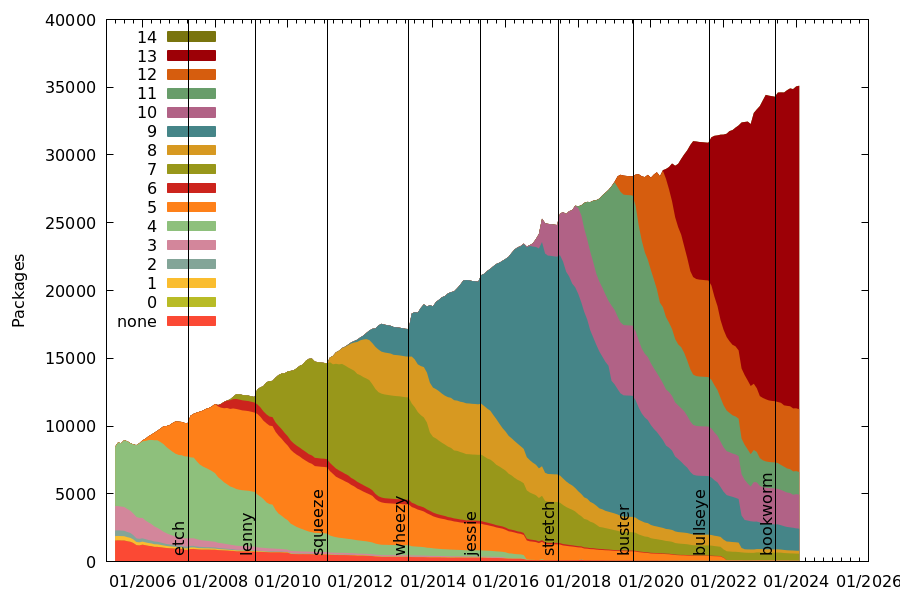
Also available:
- Same graph for Debian unstable
- Non-cumulative graph (also for Debian unstable)
- Non-cumulative graph with percent instead of packages counts (also for Debian unstable)
- Stacked graph with percent instead of packages counts (also for Debian unstable)
- Raw data as CSV (also for Debian unstable)
- Status of packages on 2025-12-01 (CSV) (also for Debian unstable)
Build systems
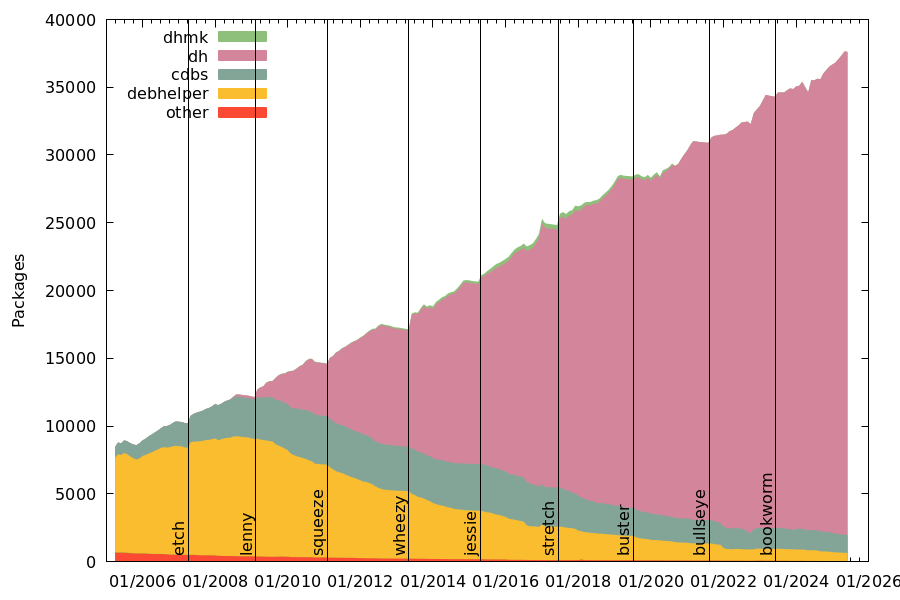
Also available:
- Same graph for Debian unstable
- Non-cumulative graph (also for Debian unstable)
- Non-cumulative graph with percent instead of packages counts (also for Debian unstable)
- Stacked graph with percent instead of packages counts (also for Debian unstable)
- Raw data as CSV (also for Debian unstable)
- Status of packages on 2025-12-01 (CSV) (also for Debian unstable)
Source formats
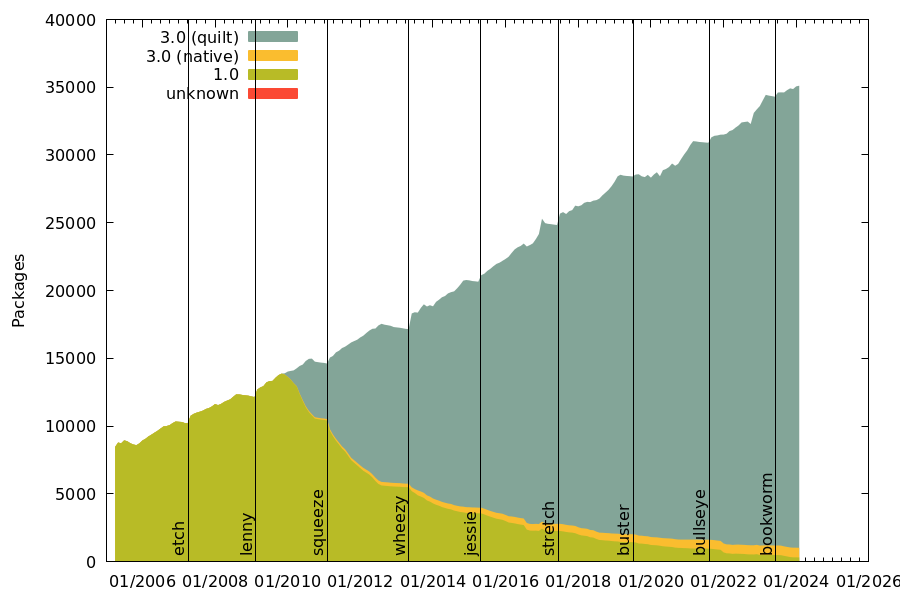
Also available:
- Same graph for Debian unstable
- Non-cumulative graph (also for Debian unstable)
- Non-cumulative graph with percent instead of packages counts (also for Debian unstable)
- Stacked graph with percent instead of packages counts (also for Debian unstable)
- Raw data as CSV (also for Debian unstable)
- Status of packages on 2025-12-01 (CSV) (also for Debian unstable)
Source formats and patch systems
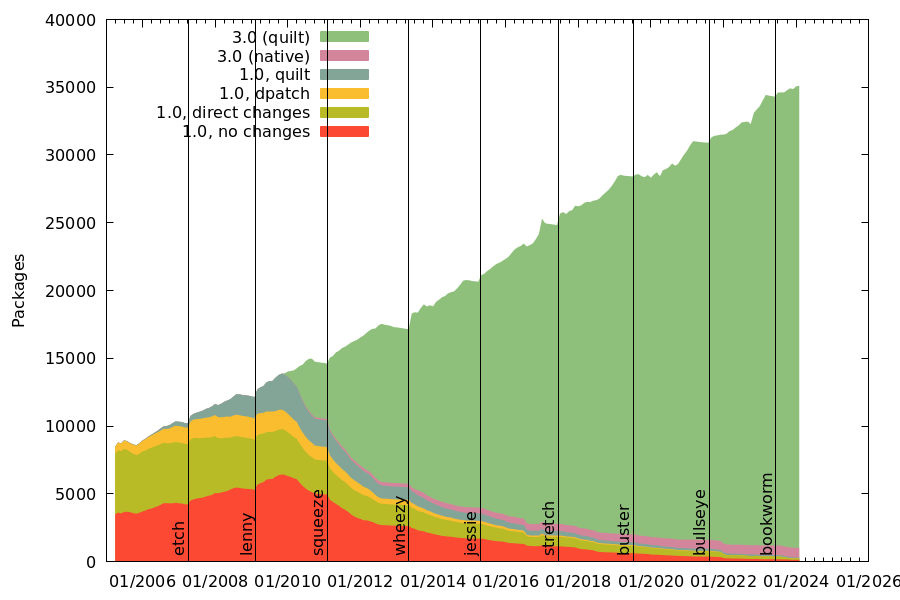
Also available:
- Same graph for Debian unstable
- Non-cumulative graph (also for Debian unstable)
- Non-cumulative graph with percent instead of packages counts (also for Debian unstable)
- Stacked graph with percent instead of packages counts (also for Debian unstable)
- Raw data as CSV (also for Debian unstable)
- Status of packages on 2025-12-01 (CSV) (also for Debian unstable)
Version Control System
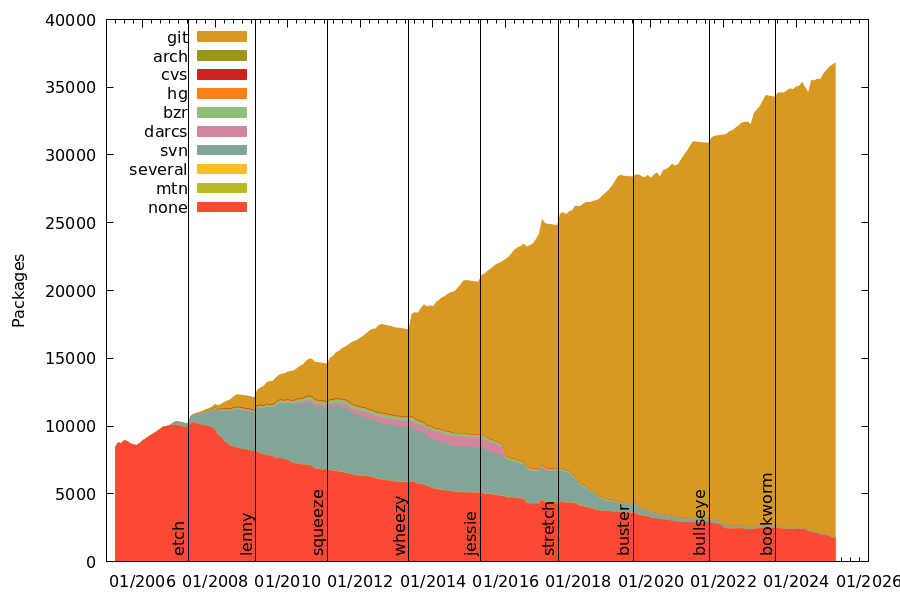
Also available:
- Same graph for Debian unstable
- Non-cumulative graph (also for Debian unstable)
- Non-cumulative graph with percent instead of packages counts (also for Debian unstable)
- Stacked graph with percent instead of packages counts (also for Debian unstable)
- Raw data as CSV (also for Debian unstable)
- Status of packages on 2025-12-01 (CSV) (also for Debian unstable)
VCS Hosting
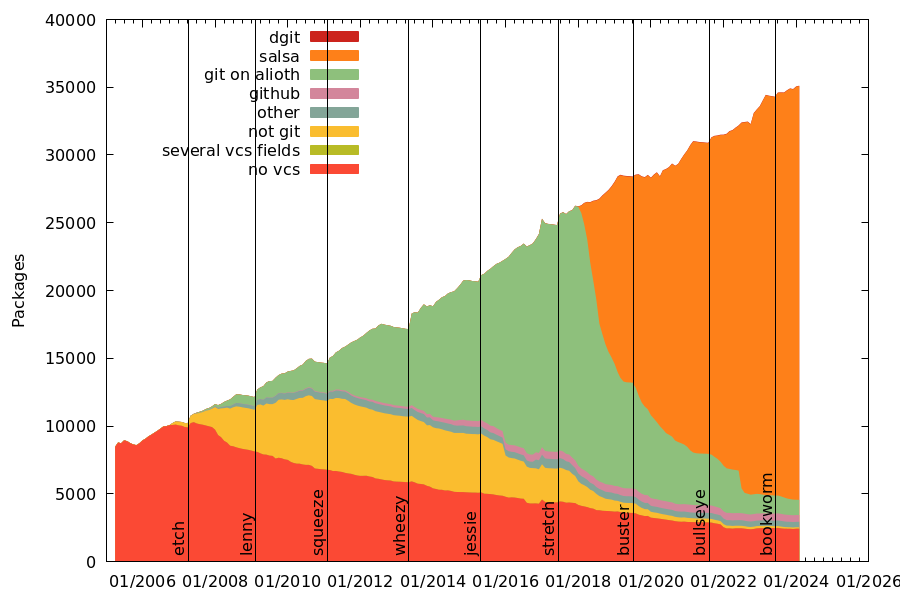
Also available:
- Same graph for Debian unstable
- Non-cumulative graph (also for Debian unstable)
- Non-cumulative graph with percent instead of packages counts (also for Debian unstable)
- Stacked graph with percent instead of packages counts (also for Debian unstable)
- Raw data as CSV (also for Debian unstable)
- Status of packages on 2025-12-01 (CSV) (also for Debian unstable)
Copyright format: machine-readable (DEP-5) vs old format
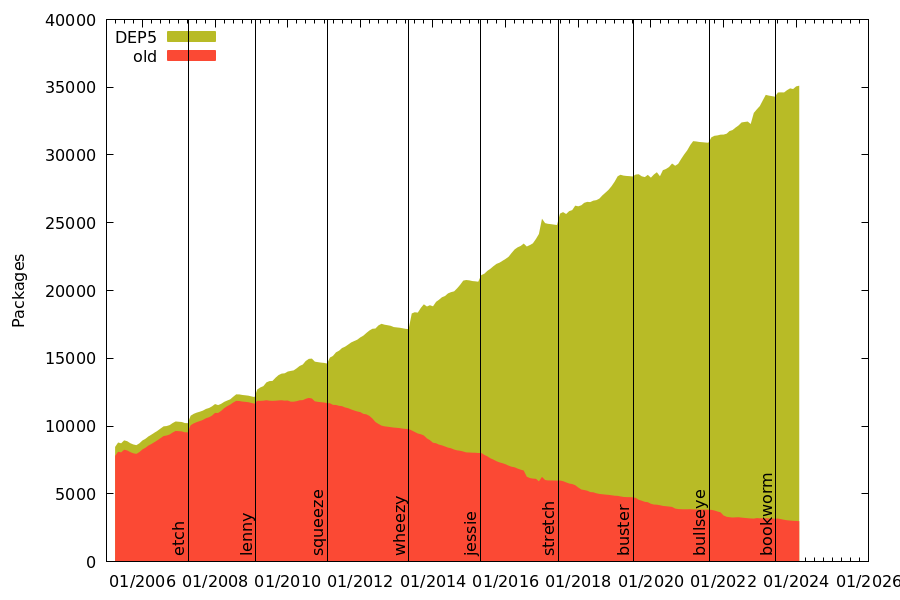
Also available:
- Same graph for Debian unstable
- Non-cumulative graph (also for Debian unstable)
- Non-cumulative graph with percent instead of packages counts (also for Debian unstable)
- Stacked graph with percent instead of packages counts (also for Debian unstable)
- Raw data as CSV (also for Debian unstable)
- Status of packages on 2025-12-01 (CSV) (also for Debian unstable)
Co-maintenance
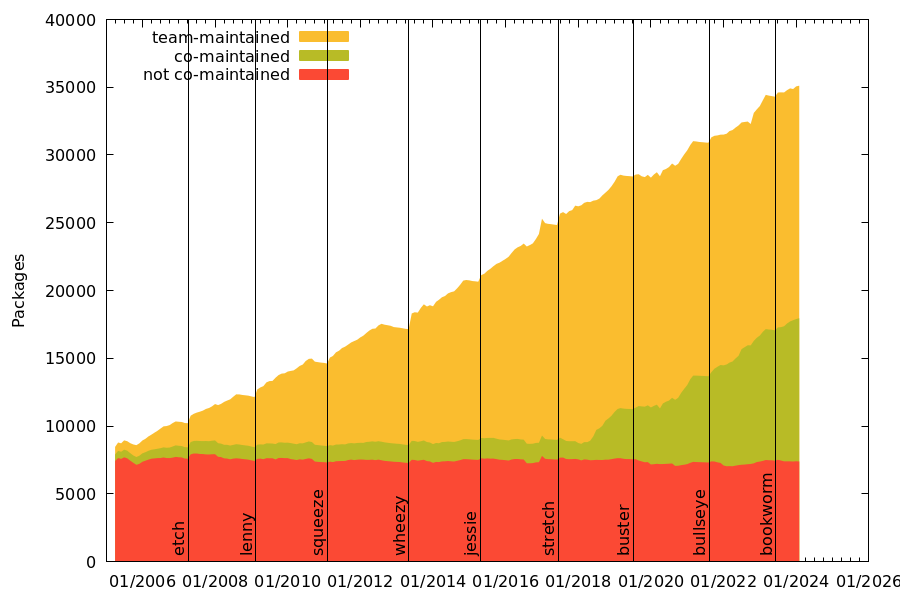
Also available:
- Same graph for Debian unstable
- Non-cumulative graph (also for Debian unstable)
- Non-cumulative graph with percent instead of packages counts (also for Debian unstable)
- Stacked graph with percent instead of packages counts (also for Debian unstable)
- Raw data as CSV (also for Debian unstable)
- Status of packages on 2025-12-01 (CSV) (also for Debian unstable)
Rules-Requires-Root
Note that "no" is now the default, so this graph is mainly interesting for the historical perspective.
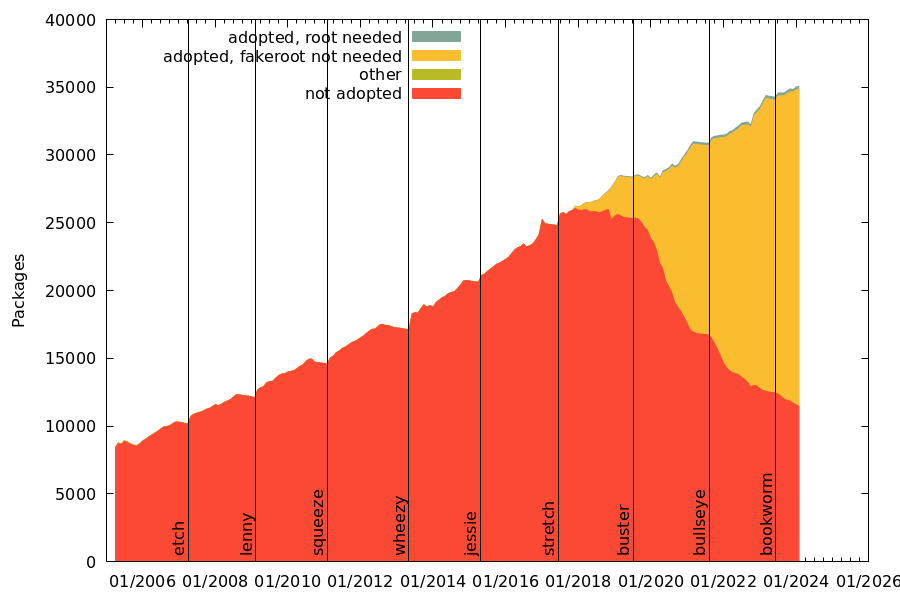
Also available:
- Same graph for Debian unstable
- Non-cumulative graph (also for Debian unstable)
- Non-cumulative graph with percent instead of packages counts (also for Debian unstable)
- Stacked graph with percent instead of packages counts (also for Debian unstable)
- Raw data as CSV (also for Debian unstable)
- Status of packages on 2025-12-01 (CSV) (also for Debian unstable)
Support for build-arch and build-indep
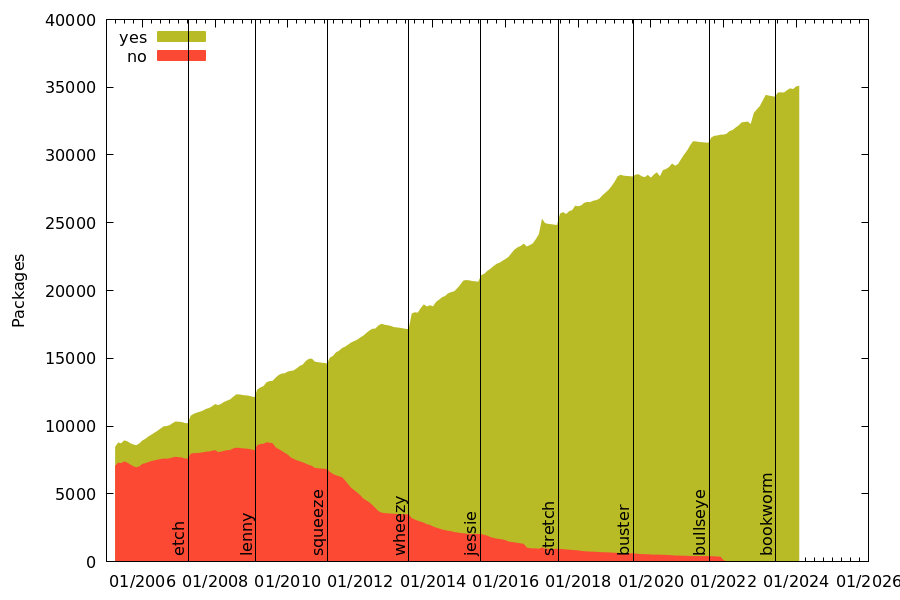
Also available:
- Same graph for Debian unstable
- Non-cumulative graph (also for Debian unstable)
- Non-cumulative graph with percent instead of packages counts (also for Debian unstable)
- Stacked graph with percent instead of packages counts (also for Debian unstable)
- Raw data as CSV (also for Debian unstable)
- Status of packages on 2025-12-01 (CSV) (also for Debian unstable)
Test suite
This tracks packages that declare a Testsuite in debian/control and/or the dsc file.
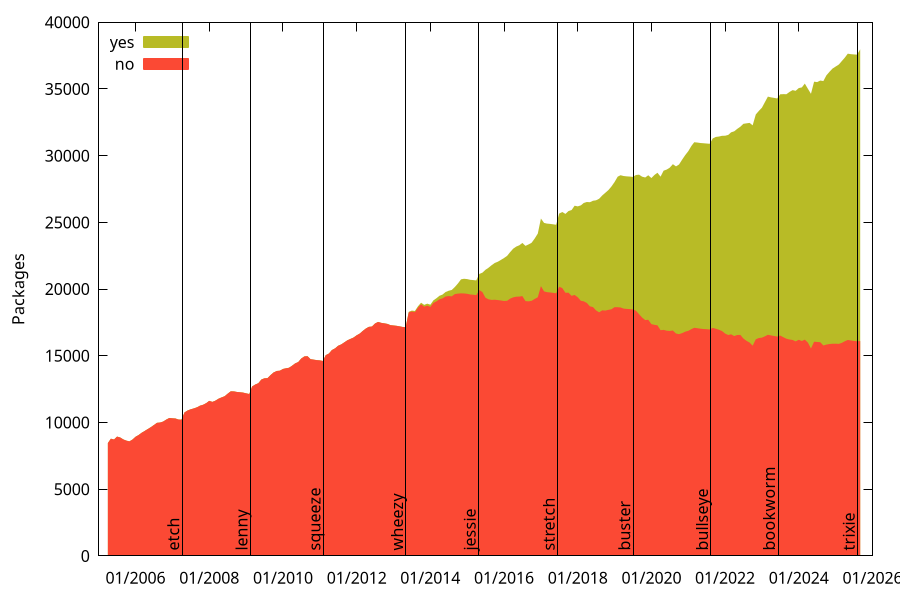
Also available:
- Same graph for Debian unstable
- Non-cumulative graph (also for Debian unstable)
- Non-cumulative graph with percent instead of packages counts (also for Debian unstable)
- Stacked graph with percent instead of packages counts (also for Debian unstable)
- Raw data as CSV (also for Debian unstable)
- Status of packages on 2025-12-01 (CSV) (also for Debian unstable)
Continuous Integration on Salsa
This graph only looks at source packages, and thus misses:
- git repositories that exclude shipping
debian/salsa-ci.ymlin source using adebian/.gitattributesfile - salsa projects that specify a CI configuration file in another project in the salsa project configuration (using
recipes/debian.yml@salsa-ci-team/pipeline)
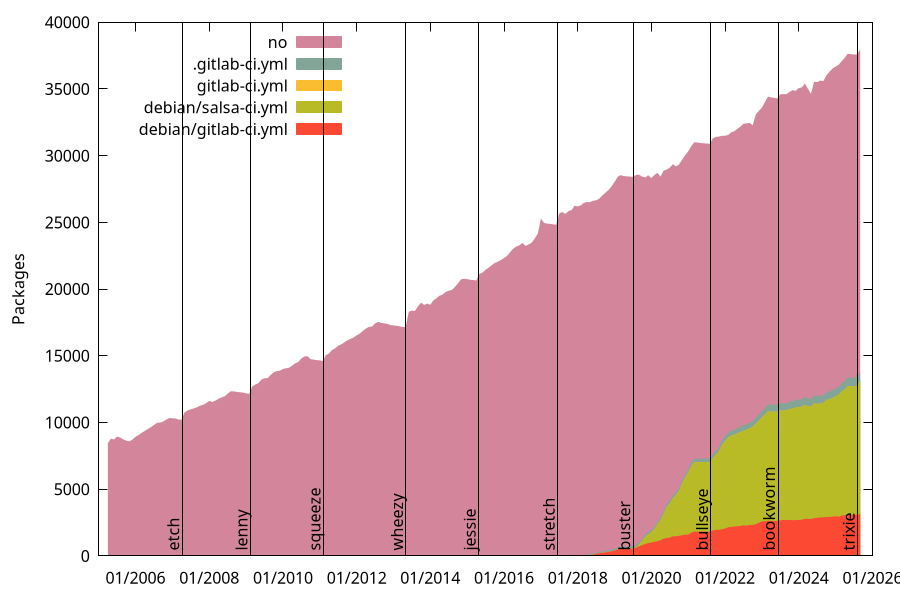
Also available:
- Same graph for Debian unstable
- Non-cumulative graph (also for Debian unstable)
- Non-cumulative graph with percent instead of packages counts (also for Debian unstable)
- Stacked graph with percent instead of packages counts (also for Debian unstable)
- Raw data as CSV (also for Debian unstable)
- Status of packages on 2025-12-01 (CSV) (also for Debian unstable)
git-buildpackage
This tracks packages that use git-buildpackage by checking for presence of debian/gbp.conf. It misses packages that use git-buildpackage but do not include a debian/gbp.conf file.
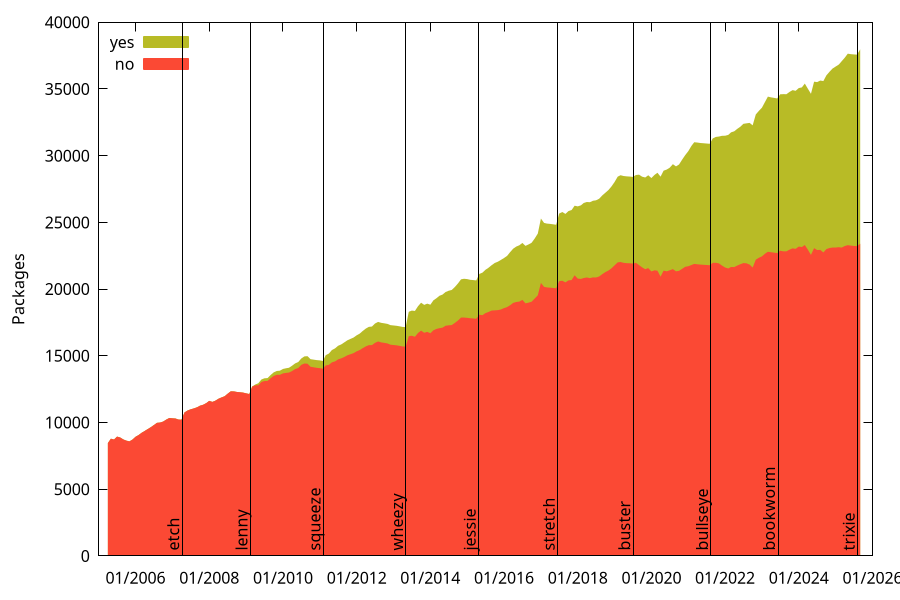
Also available:
- Same graph for Debian unstable
- Non-cumulative graph (also for Debian unstable)
- Non-cumulative graph with percent instead of packages counts (also for Debian unstable)
- Stacked graph with percent instead of packages counts (also for Debian unstable)
- Raw data as CSV (also for Debian unstable)
- Status of packages on 2025-12-01 (CSV) (also for Debian unstable)
debian/watch version
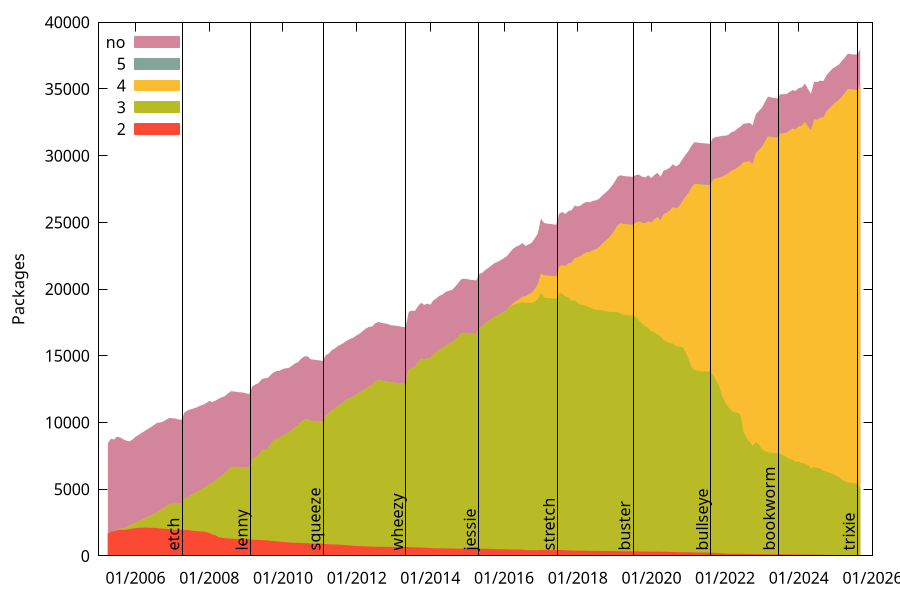
Also available:
- Same graph for Debian unstable
- Non-cumulative graph (also for Debian unstable)
- Non-cumulative graph with percent instead of packages counts (also for Debian unstable)
- Stacked graph with percent instead of packages counts (also for Debian unstable)
- Raw data as CSV (also for Debian unstable)
- Status of packages on 2025-12-01 (CSV) (also for Debian unstable)
Uploads using dgit and tag2upload
This is based on the analysis of the Dgit and Git-Tag-Info fields in the dsc file.
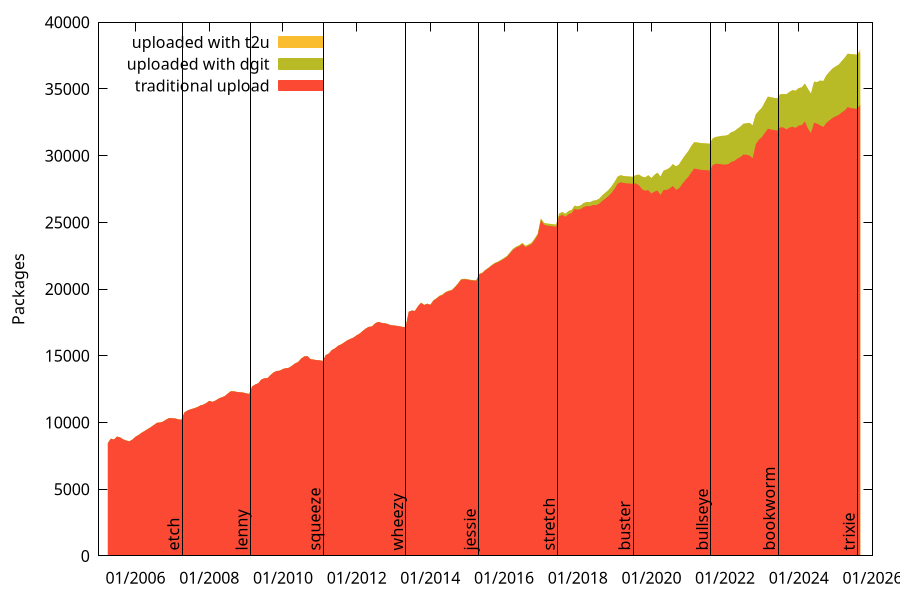
Also available:
- Same graph for Debian unstable
- Non-cumulative graph (also for Debian unstable)
- Non-cumulative graph with percent instead of packages counts (also for Debian unstable)
- Stacked graph with percent instead of packages counts (also for Debian unstable)
- Raw data as CSV (also for Debian unstable)
- Status of packages on 2025-12-01 (CSV) (also for Debian unstable)
Smells
Inspired by code smells (any characteristic in the source code of a program that possibly indicates a deeper problem), this page also provides a list of packages that should be refreshed to newer standards.
This is subjective (and feel free to criticize, but I might feel free to ignore critics :-) ). Here is the logic:
- Debhelper compatibility level: on 2024-08-01, 97.9% of packages in testing have a debhelper compatibility level of 9 or higher (9: 3%; 10: 6%; 11: 4%; 12: 12%; 13: 69%; 14: 0%). Therefore, using a debhelper compatibility level lower than 9 is a smell.
- Build system: on 2024-08-01, 93.5% of packages in testing use dh (others: cdbs: 4%; debhelper: 2%; other: 0%; : 0%). So, not using dh is a smell.
- Source format and patch system: on 2024-08-01, 99.4% of packages in testing use 3.0 (quilt) (97.4%) or 3.0 (native) (2.0%). Therefore, not using 3.0 is a smell
- VCS: On 2024-08-01, 93.8% of packages use Git, 6.0% use no VCS at all, and 0.2% use another VCS. 88.4% use Git on Salsa, and 2.8% use Git on Alioth (and will likely move to Salsa). Therefore, not using Git and Salsa is a smell (except if the package is using dgit).
- Overall, 86.1% of packages use a debhelper compatibility level >= 9, dh, 3.0 (native) or 3.0 (quilt), Git, and either Salsa or Alioth.
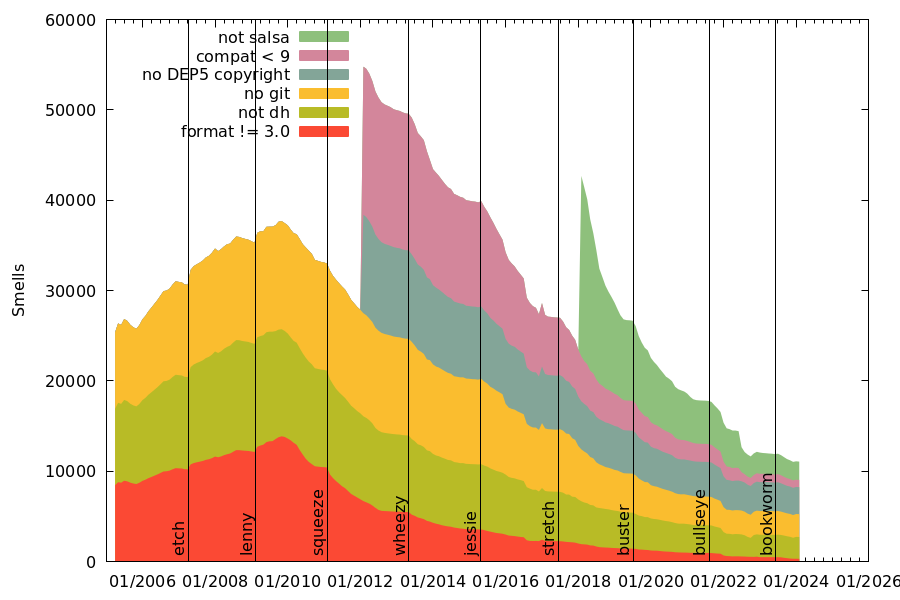
Also available:
- Same graph for Debian unstable
- Non-cumulative graph (also for Debian unstable)
- Raw data as CSV (also for Debian unstable)
Contact: Lucas Nussbaum <lucas@debian.org>. See Introduction for pointers to source code.